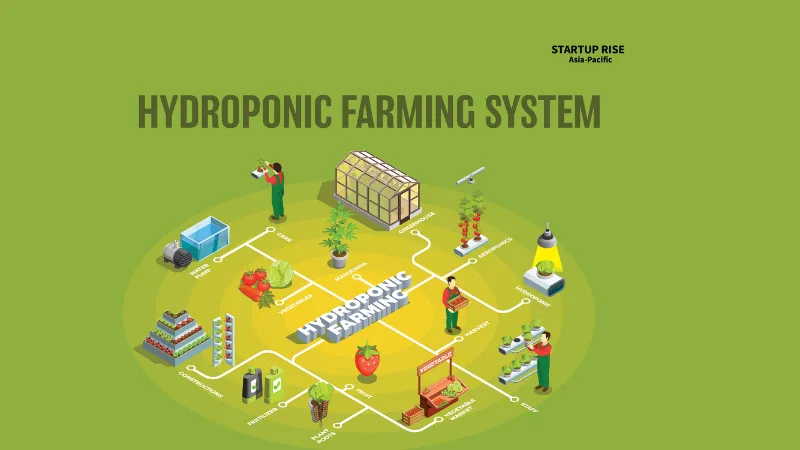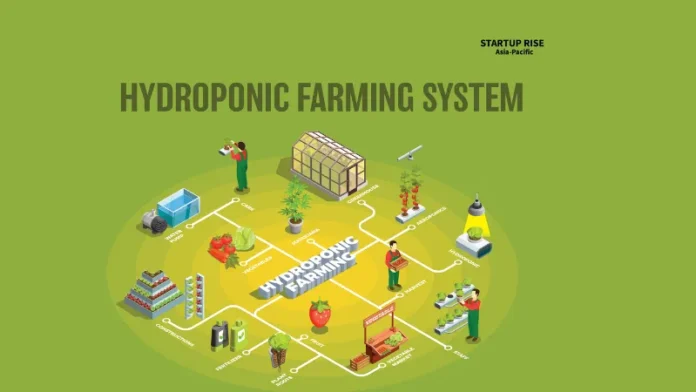
As the global population rises, fertile agricultural land is shrinking, increasing the need for innovative farming solutions. Hydroponics presents a promising option by maximizing limited space allowing crops to be grown efficiently in small areas. The demand for fresh, locally grown produce is especially high in urban areas making hydroponic farming even more attractive. The hydroponics market is expected to grow significantly, reaching an estimated value of $23.37 billion by 2032 due to its many advantages.
In this article, we will learn what hydroponic farming is, how it works and what benefits it offers. As global warming continues to rise, hydroponics can play a vital role in overcoming food shortages in the coming years.
What is hydroponic farming?
Hydroponic farming is a method of growing plants without using soil. This method of farming uses a water-based nutrient solution to nourish the roots. The word “hydroponics” comes from Greek words which mean “working water”.
The hydroponics farming method directly provides plants with all the necessary nutrients through water and eliminates the need for soil. Although outdoor growing is possible, most hydroponic farming is done indoors or in greenhouses. This method is also highly water-efficient and uses up to 90% less water than traditional farming.
Hydroponic farming offers several key benefits, making it an appealing alternative to traditional farming methods. It helps reduce the environmental impact by using fewer resources and minimizing soil degradation. One of its major advantages is water conservation, as hydroponic systems recirculate water, which uses much less water than conventional farming. Additionally, it makes more efficient use of limited space and enables vertical farming or indoor setups where land is limited. Finally, hydroponically grown plants are healthier and more nutritious, as they have direct access to the nutrients they need without the risks of soilborne diseases.
The hydroponic farming method can be used by small farmers, hobbyists, and large-scale commercial growers. There are different systems, like nutrient film technique (NFT) or run-to-waste, to support plant growth.
How to do hydroponic cultivation?
The hydroponic farming system gives plants exactly what they need—nutrients, water, light, and oxygen at the right time. This highly controlled environment allows for faster growth, etter yields and healthier plants since factors like temperature, pH levels and light exposure can be adjusted.In a typical hydroponic system, plants grow in trays with water or a non-soil medium like sand or rock. The nutrient solution is kept in a reservoir and pumped into the trays, sometimes with air pumps to ensure oxygen is supplied to the roots. Grow lights and larger systems might include software to monitor plant health and nutrient levels.
Importance of hydroponic in agriculture
Hydroponics is a farming technique where plants are grown in a nutrient-rich water solution instead of soil and offers several benefits over traditional farming:
- Higher Yields: Hydroponic systems can produce 3 to 10 times more food in the same space as traditional farming.
- Water Efficiency: Hydroponics uses up to 10 times less water than conventional methods because water is recirculated in a closed system.
- Less Contamination: Since there’s no soil, there are no pesticide or fertilizer residues, leading to cleaner food.
- Plant Protection: The controlled environment reduces exposure to pests and diseases, protecting plants.
- Optimal Growing Conditions: Hydroponics allows precise control over factors like pH, nutrient levels, and light, boosting plant growth.
- Eco-Friendly: It’s more sustainable as it uses fewer resources, produces less waste and doesn’t require pesticides.
- Fresh, Local Food: Hydroponics can grow fresh food in areas with poor soil or water scarcity, making it ideal for regions with droughts or limited agricultural space.
- Efficient Crop Management: No weed growth and less water is needed, making it easier to manage crops.
Additionally, hydroponics allows for higher plant density. They can be grown closer together since plants are not restricted by soil. Plants can be grown even vertically which makes the most of available space. This makes it possible to grow more plants in smaller areas, such as in a warehouse.
What are the types of hydroponic farming systems?
Hydroponic farming offers several systems, each suited to different needs and plant types. Here’s a breakdown of the six basic types of hydroponic systems:
Wick System
The wick system is simple and space-efficient. It uses an absorbent material (the wick) to draw nutrient-rich water from a reservoir to the plant’s roots. This system doesn’t require pumps or electricity that’s why it works well for small plants and herbs it.
Deep Water Culture (DWC)
In the DWC system, plants are suspended in continuously aerated water to ensure the roots have access to nutrients and oxygen. In this method, the roots of the plants are submerged in a nutrient solution which makes it a very direct way to provide plants with all they need. This system is considered one of the purest forms of hydroponics. It offers fast growth and healthy plants. It’s great for crops like lettuce and herbs, but it needs careful monitoring to prevent water stagnation.
Nutrient Film Technique (NFT)
The NFT system involves a thin stream of nutrient solution that constantly flows over the roots of plants. The plants are placed in the tray at a slight tilt, so that the solution can flow easily and the roots can absorb the nutrients. NFT is a low-consumption and modular system that is easy to scale. However, it requires a steady flow of water and if the pump fails, the plants can dry out quickly.
Ebb and Flow (Flood and Drain)
The ebb and flow system is versatile and works well for a wide variety of plants. It works by pumping nutrient solution into the plant roots at set intervals and then releasing the water back into the reservoir. This process promotes oxygenation, which is beneficial to root health. This system can be adapted to different plant types by adjusting flooding times and nutrient levels. This is a great option for larger or more diverse crops.
Drip System
The drip system delivers nutrient solution directly to each plant’s roots through tubes, one drop at a time. The system is highly customizable and allows for adjusting the amount of solution based on the needs of different crops. It efficiently reduces water waste by returning excess solution to the reservoir. Drip systems are typically used in large, commercial setups and can be adapted to various crops.
Aeroponics
Aeroponics is one of the most advanced hydroponic systems. In this method plant roots are suspended in the air and periodically misted with a nutrient solution. This method offers excellent oxygen exposure for the roots which leads to faster growth. It’s ideal for high-value crops like herbs and strawberries. However, aeroponics method requires more maintenance and monitoring, as the misting system must be perfectly calibrated to avoid destroying the roots.
How is a vertical hydroponic system different from a regular hydroponic system?
Vertical hydroponic systems are designed to grow plants in a vertical setup. It helps in maximizing space by stacking plants and using gravity-fed water flow. They are ideal for small spaces like balconies or rooftops. It offers higher yields per square foot. Plants grow faster and are harvested more frequently compared to traditional systems. Vertical systems also provide better light exposure and are easier to maintain. They typically don’t use growing substrates like traditional hydroponics.
Benefits of hydroponic vertical farming
Hydroponic vertical farming offers several benefits:
- Space Efficiency: It makes the most of limited space by growing crops vertically, which is ideal for urban areas, rooftops, and small spaces, allowing more food to be produced in less space.
- Water Efficiency: Vertical systems use up to 95% less water than traditional farming because the water is recirculated, making it a sustainable option, especially in limited regions.
- Consistent Crop Quality: Since vertical farming is done in a controlled environment, crops can be grown consistently throughout the year and are free from the effects of changing weather or seasons.
- Reduced Transport Costs: Growing food closer to urban areas reduces transportation costs and carbon emissions and ensures quicker access to fresh produce.
- Fewer Pesticides: The sterile, soil-free environment helps eliminate pests and diseases. It also reduces the need for pesticides and results in cleaner and healthier crops.
- Year-Round Production: Vertical farming allows continuous cultivation and harvests throughout the year and ensures a steady fresh food supply.
- Higher Yield: Vertical farming can produce higher yields in less space than traditional farming, making it a highly efficient method.
How expensive is it to start hydroponic farming?
The cost of setting up a hydroponic farm in Asia can vary based on the farm’s size and complexity.
A basic Small-scale system of a 500 sq ft farm can cost up to $110,000.
Larger, automated farms of 1,000 sq ft may cost between $500,000 and $800,000.
Setting up a Commercial operation of a large-scale hydroponic farm can exceed $100,000.
The high initial cost is due to the expensive pieces of equipment like grow lights, nutrient delivery systems, climate control systems, greenhouse infrastructure, pumps, reservoirs, and trays are needed. Additionally, this equipment must be upgraded every 3–4 years to maintain or improve farm productivity.
Conclusion
Hydroponic farming offers a fast, efficient and sustainable method for growing plants which makes it popular for both small and large-scale operations. Hydroponics allows plants to grow more quickly and with less water than traditional farming by using nutrient-rich water instead of soil. This system reduces risks such as pests, diseases and unpredictable weather as well as also eliminates the need for pesticides.
Hydroponics is a versatile farming method that supports a wide variety of crops like leafy greens, herbs and tomatoes and is adaptable to different spaces and skill levels. Hydroponic systems provide higher yields, better quality produce and year-round growing, all while being eco-friendly and space-efficient. As global warming is increasing day by day hydroponic methods can help in addressing the scarcity of nutritious food around the world.
FAQs
What is hydroponic farming and how does it work?
Hydroponic farming is a method of growing plants without soil, using nutrient-rich water to deliver essential minerals directly to the roots.
What are the main types of hydroponic systems?
Common types include Deep Water Culture (DWC), Nutrient Film Technique (NFT), Drip System, Ebb and Flow, Wick System, and Aeroponics.
What are the advantages of hydroponic farming?
Benefits include faster plant growth, higher yields, space efficiency, water conservation, and reduced use of pesticides.
Is hydroponic farming expensive to start?
Initial setup costs can vary depending on the scale and system type, but long-term water, fertilizer, and space savings can balance the investment.





